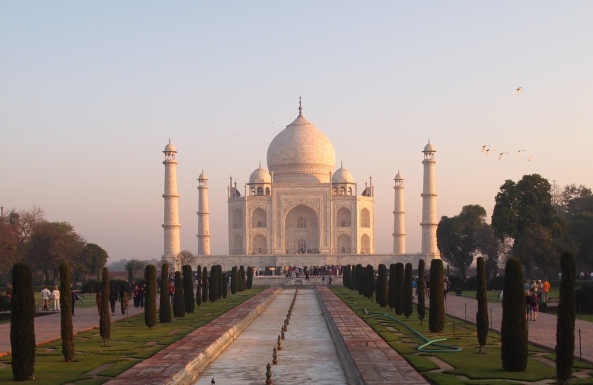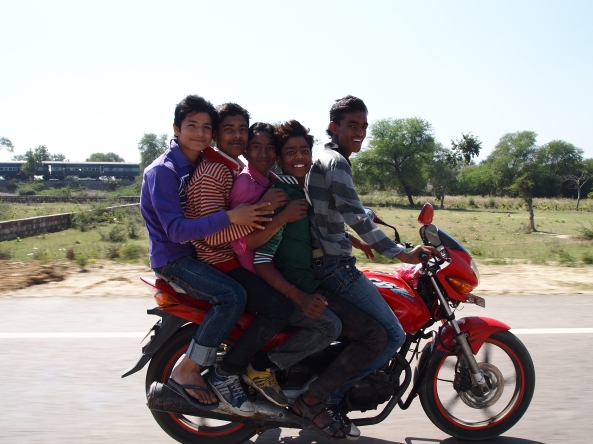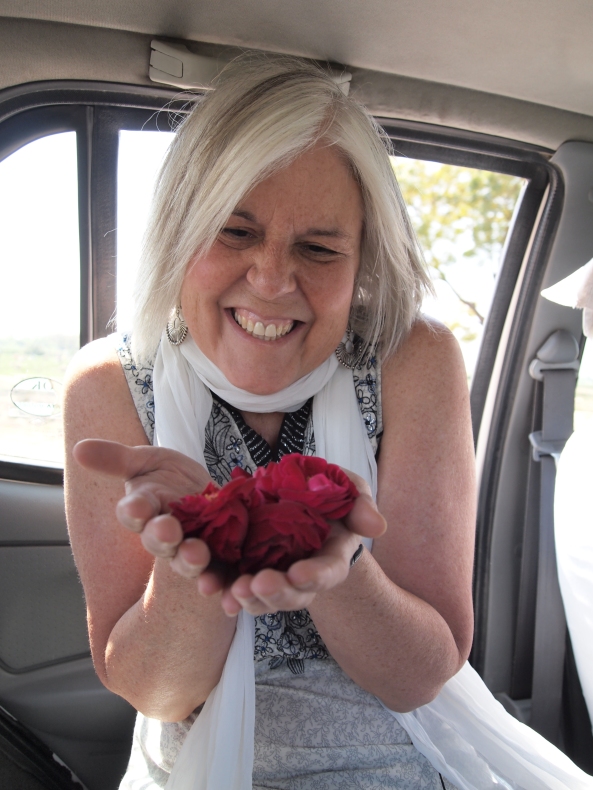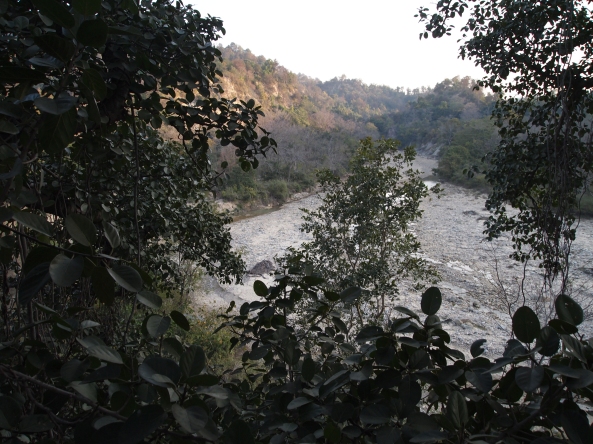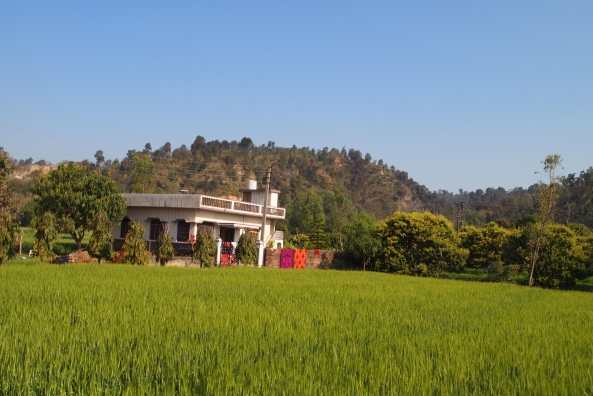Saturday, March 12: The Taj Mahal
After eating a breakfast of omelets in the sweltering merry-go-round restaurant in the Hotel Pushp Villa, we head to the long-awaited Taj Mahal. We are dressed our part as Indian princesses for this special day, wearing our salwar kameez and flowing scarves. Singh must drop us quite a way off, because there is a perimeter within which cars are not allowed. Apparently the polluting cars are kept from getting too close to the Taj Mahal because of resulting discoloration. We wait in a slow-moving line to buy our tickets, which are 750 rupees for tourists, and then at the main gate of the Taj, we wait in another long women-only line to have our bags checked and our bodies scanned.
It is well-known that the Taj Mahal was built by Shah Jahan as a memorial to his second wife, Mumtaz Mahal. She died giving birth to their 14th (!) child in 1631. The emperor was so heartbroken by her death that his hair turned gray virtually overnight. Construction of the Taj began that year and though the main building was completed in 8 years, the entire complex took 22 years. Soon after it was finished, Shah Jahan was deposed by his son Aurangzeb. He was imprisoned in Agra Fort, across the river from the Taj, where for the remaining days of his life he could only gaze out the window longingly at his creation. Shah Jahan died in 1666 and was buried beside Mumtaz in the mausoleum.
We enter through the south gate, which is a 30 meter high red sandstone gateway inscribed with verses from the Quran. Once we pass through the gate, we can see the Taj Mahal, standing on a raised platform at the far end of the ornamental gardens, with the Yamuna River behind. Because the river is behind and because it sits on a platform, its backdrop is simply the beautiful sky. There are no unsightly buildings behind to detract from the vision. Since we are here close to sunrise, the backdrop is brushstrokes of lavender, purple and coral. It’s stunning.
The ornamental gardens are designed in the style of formal Persian gardens, a square divided by watercourses, with an ornamental marble plinth at its center. Usually, in pictures, I have seen the Taj beautifully reflected in the watercourses. However, today, there is no water at all in the watercourses. Why that is, I have no idea, but it’s very irritating. Why can’t the Indians keep anything properly maintained and running? Our trip to India has shown Indian government at its worst. The Taj Mahal is arguably the most beautiful building in the world and is the biggest tourist attraction in India. You would think that because of this, the monument would be sparkling and spiffy ALL THE TIME! However, on this day, it looks like a poorly maintained tourist attraction. People always say the Taj Mahal NEVER disappoints. It’s still beautiful, but these dried up watercourses definitely detract from the beauty. Slightly, yes, it DOES disappoint.
We spend quite a long time wandering around the grounds, watching the people, admiring the gardens, touching the semi-translucent white marble walls and the relief-carved flowers, and studying the beautiful patterns of inlaid semi precious stones. The building is really so lovely, with its white minarets at each corner of the raised marble platform. The vaulted arches on its facade are embellished with Quran quotations in inlaid jasper calligraphy. The central bulbous dome is surrounded by four small domes. Inside the central chamber, light streams through finely cut marble screens. We can’t view the tombs of Shah Jahan and Mumtaz Mahal, as they are in a locked basement beneath the main chamber.
Standing on the river side of the Taj, we can see Agra Fort, where the sad Shah Jahan was imprisoned by his own son. This fort was begun by Emperor Akbar in 1565 and his grandson, Shah Jahan, made additions using his favorite material of white marble. Intended to be a military structure, Shah Jahan transformed it into a palace. Later it became his prison for eight years until his death, after his son seized power in 1658.
We spend quite a lot of time here just soaking up the magnificence of the Taj Mahal. The TAJ MAHAL!! I can’t believe we are here seeing this. It is lovely with its exquisite setting and its mournful story. In a dream-state, we wander and sit on the benches, soak up the atmosphere and watch the hordes of Indian families and tourists against the backdrop of the world’s most beautiful building.
We return to the Pushp Villa where Singh is waiting to drive us on the next leg of our trip. We are heading to Jaipur today, and on the way we will stop at Fatehpur Sikri. We load up our stuff and get on the road. On our way out of Agra, as we crawl out of the town, five boys squeezed onto one motorcycle ride along beside us and surprisingly throw a bunch of roses into the car. Sweet!
Fatehpur Sikri
Fatehpur Sikri is a fortified ancient city about 40 km west of Agra, and the drive takes us a little over an hour. It was the short-term capital of the Mughal empire between 1571-1585, while Emperor Akbar was the head honcho. Emperor Akbar came here to consult the Sufi saint Shaikh Salim Chishti, who predicted the birth of an heir to the Mughal throne. When his prophecy came true, the Emperor built his capital here, with a mosque and three palaces for each of his favorite wives: one a Christian, one a Muslim and one a Hindu. Because of water shortages in the area, the capital was abandoned shortly after Akbar’s death.
Singh has to drop us some distance from the city, where we must take a bus. On the bus are really obnoxious guys trying to sell us tacky trinkets. They won’t take no for an answer and keep hounding everyone who is captive on the bus until someone buys something. This place is one of the most annoying because of these persistent salesmen. When we get off the bus, more boys swarm around us trying to convince us to hire them as guides. We wave them all off.
Inside the gates, the palace walls are a rich red sandstone, set off by emerald-green grass and colorful flower gardens. The first palace is the largest, that of Jodh Bai, Akbar’s Hindu wife who is said to have been his favorite. It boasts traditional Indian columns, Islamic cupolas and turquoise-blue Persian roof tiles and is set around a huge courtyard.
Near the Hindu wife’s palace is the Christian wife’s palace, used by Akbar’s wife Mariam, who gave birth to Jehangir here in 1569. It contains elements of different religions, reflecting Akbar’s tolerance for other religions. The domed ceiling is Islamic in style and holds remnants of a painting of the Hindu god Shiva.
As we head north from an Ornamental Pool, we come to the most intricately carved, tiny but elegant Rumi Sultana, the palace built for Akbar’s Turkish Muslim wife. Though I’m not crazy about a man who feels the need to have three wives, Jayne and I have to admire someone who makes sure he marries women of different faiths, putting each wife on equal footing.
The Diwan-i-Am, or the Hall of Public Audiences, is a large courtyard which is now a garden. Here Akbar dispensed justice through public executions, with elephants trampling convicted criminals to death. At the northern end of the garden is the Hall of Private Audiences, or Diwan-i-Khas. Its interior is dominated by a beautifully carved central column. At the top is a flat-top plinth, where Akbar stood to debate with scholars in the four corners of the room, connected by narrow stone bridges.
On one corner of the Ladies Garden is the Panch Mahal, a pavilion with five stories that decrease in size until the top one which is the size of a tiny kiosk. The entire setting is lovely with the gardens and the red sandstone pavilion.
Next to the entire complex is the Caravanserai, a vast courtyard surrounded by rooms looking like an old-fashioned motel. In these rooms, visiting merchants stayed.
After walking through this, we come upon Jama Masjid, an immense mosque of Persian and Indian design. In the courtyard of the mosque is the white-marble tomb of Shaikh Salim Chishti, which we enter through a door made of ebony. Brightly colored flower murals and a canopy of mother-of-pearl shell enclose the interior. Inside everyone is filing past a marble altar and piling up colorful scarves on it. I don’t really know what this is for, possibly couples wishing for children, since the saint prophesied about Akbar’s son in that long past century. Childless women do in fact visit this tomb today to tie threads to the marble screens, in hopes of conceiving a child.
After taking the bus back to meet Singh in the parking lot, we are accosted once again by myriads of touts trying to lure us into a bazaar which is quite nice. We would have wandered through there anyway, so it is irritating to have to fend off these annoying men and boys. After exploring the bazaar, we walk to meet Singh, where we are accosted by more young boys begging us to give them our tickets to Fatehpur Sikri. Later Singh tells us these boys try to resell the tickets to make money for themselves.

pilgrims traipse by and place scarves on the central altar of the saint’s tomb… possibly in hopes of conceiving a child??
We get back in the car for the long drive to Jaipur. We are surprised to find a multi-lane limited use highway, much like what we have in America. This is the best highway we have encountered in India and it is nearly a smooth and relaxing ride to Jaipur. Along the way, we stop at tourist shop for a bathroom and snack break. Inside we explore the tourist shop and suddenly I am face to face with two girls I recognize!! We all stop in our tracks and stare at each other. They say, Oh my gosh! Do you remember us? We were all on the same trip to China in September. They remind me their names are Jen and Jenni, and though I don’t recall their names, I do remember their faces. We had all taken a tour to Beijing from Korea in September during the Chuseok holiday. What a shock, to meet these girls at a highway rest stop in India! What a strange and tiny world it is.
When we arrive in Jaipur, Singh drops us at our hotel, Nahargarh Haveli. This hotel sits on a nondescript side street where the road is mostly torn up for construction. However, inside we find a lovely hotel, with stained glass windows and lovely painted ceilings. Our rooms is perfectly nice. What a surprise. We ask Singh if he will drive us to Reds, a slick bar overlooking the Raj Mandir cinema. We relax on red leather couches in the ultra-modern bar and drink beers and eat snacks of cauliflower and corn cakes with sauces. We love this place! Feeling pretty good after several beers, we head back to the room to read and sleep for an early morning exploring the Pink City.


